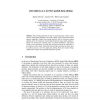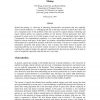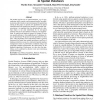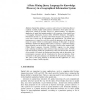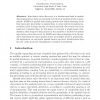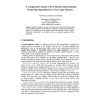FSKD
2010
Springer
14 years 3 months ago
2010
Springer
Uncertainty is the intrinsic property of spatial data and one of important factors affecting the course of spatial data mining. There are diversiform forms for the essentiality an...
WSCG
2004
14 years 6 months ago
2004
In many application domains, data is collected and referenced by its geo-spatial location. Spatial data mining, or the discovery of interesting patterns in such databases, is an i...
TSDM
2000
14 years 8 months ago
2000
The growing production of maps is generating huge volume of data stored in large spatial databases. This huge volume of data exceeds the human analysis capabilities. Spatial data m...
VLDB
1994
ACM
14 years 9 months ago
1994
ACM
Spatial data mining is the discovery of interesting relationships and characteristics that may exist implicitly in spatial databases. In this paper, we explore whether clustering ...
VLDB
1997
ACM
14 years 9 months ago
1997
ACM
Spatial data mining, i.e., discovery of interesting characteristics and patterns that may implicitly exist in spatial databases, is a challenging task due to the huge amounts of s...
KDD
1998
ACM
14 years 9 months ago
1998
ACM
1 The number and the size of spatial databases, e.g. for geomarketing, traffic control or environmental studies, are rapidly growing which results in an increasing need for spatial...
BTW
1999
Springer
14 years 9 months ago
1999
Springer
Abstract: Spatial data mining algorithms heavily depend on the efficient processing of neighborhood relations since the neighbors of many objects have to be investigated in a singl...
CINQ
2004
Springer
14 years 10 months ago
2004
Springer
Spatial data mining is a process used to discover interesting but not explicitly available, highly usable patterns embedded in both spatial and nonspatial data, which are possibly ...
IEAAIE
2005
Springer
14 years 10 months ago
2005
Springer
Association rules discovery is a fundamental task in spatial data mining where data are naturally described at multiple levels of granularity. ARES is a spatial data mining system ...
AI
2005
Springer
14 years 10 months ago
2005
Springer
Spatial clustering is an active research area in spatial data mining with various methods reported. In this paper, we compare two density-based methods, DBSCAN and DBRS. First, we ...

